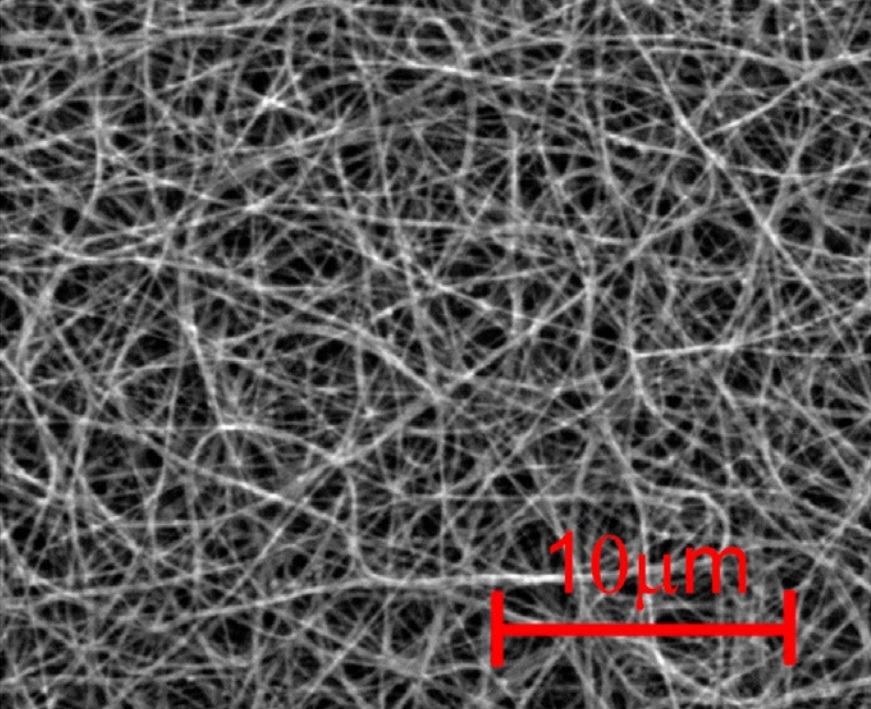Physicists at Moscow Institute of Physics and Technology (MIPT) and Skolkovo Institute of Science and Technology (Skoltech) have discovered a method to alter and intentionally tune the electronic properties of carbon nanotubes to fulfill the needs of novel electronic devices.
 Carbon nanotube film under a scanning electron microscope. Image Credit: Skolkovo Institute of Science and Technology.
Carbon nanotube film under a scanning electron microscope. Image Credit: Skolkovo Institute of Science and Technology.
The study has been published in the Carbon journal.
Carbon nanomaterials are an extensive class of compounds that consists of fullerenes, graphene, nanofibers, nanotubes and more. Even though the physical properties of several of these materials already appear in textbooks, researchers continue to make new structures and find methods to utilize them in real-life applications.
Macro structures developed as randomly oriented films created of carbon nanotubes appear to look like very thin cobwebs having an area that reaches several dozen square centimeters and thickness of just a few nanometers.
Carbon nanotube films exhibit an incredible combination of physical and chemical properties, like flexibility, stretchability, mechanical stability, outstanding adhesion to several substrates, chemical inertness, unusual optical and electrical properties.
Dissimilar to metallic films, such highly conducting films seem to be light and flexible and, thus, can be utilized in several electrical devices, like modulators, electromagnetic shields, bolometers, antennas and so on.
The awareness of the basic physical principles is vital for the effective use of the films’ electrodynamic and electrical properties in real life. The terahertz and far infrared spectral bands with wavelengths of 2 mm to 500 nm are of particular interest, where the films display typical metallic conductor properties.
Researchers from MIPT and Skoltech analyzed films conductivity in the terahertz and infrared bands with the help of films synthesized by the gas phase deposition technique. Few of the films were created of nanotubes with lengths varying from 0.3 to 13 µm, while others were treated with oxygen plasma for around 100 to 400 seconds and altered their electrodynamic properties in the process.
In a previous study, the authors demonstrated that the conductivity of high-quality pristine films could be precisely explained utilizing the conductivity model valid for metals. In such films, free electrons consist of sufficient energy to overcome possible barriers at the intersections of separate nanotubes and could move very easily over the full film, leading to high conductivity.
But reducing tubes length (down to 0.3 μm) or exposing films to plasma (for longer than 100 seconds) results in a drop in conductivity at low terahertz frequencies (<0.3 THz). The researchers found out that in both cases conductivity varies in much of the same way and generates similar outcomes.
Exposure to plasma results in a bigger amount of defects and, thus, a bigger amount of potential barriers for itinerant electrons. The number of barriers per unit area also increases, for shorter nanotubes.
The barriers strongly affect the conductivity of both nanotubes and films at direct current (DC) and quite low frequencies. Due to low temperatures, electrons tend to lack kinetic energy to overcome potential barriers.
The authors displayed that, at high enough frequencies, electrons circulate freely as if the barriers were not present. At low frequencies and in the DC case, films are created of short or plasma-treated tubes that have a greater temperature coefficient of resistance (TCR), which shows how resistance varies with temperature.
For plasma exposure of more than100 seconds or nanotube lengths below 0.3 μm, TCR achieves saturation. The effect can be taken into account as a precursor of TCR reduction in the films that are vulnerable to plasma for a very long time when individual tubes become severely damaged and lose their strange electric properties.
MIPT and Skoltech researchers plan to continue studying modified films, including those stretched in one or more directions.
In contrast to nanotubes that have long been studied in great detail, research on macro objects, such as nanotube films, started only recently. Nanotube films are much lighter and more stable chemically and mechanically than metallic films and, therefore, are more appealing for electronics applications.
Boris Gorshunov, Study Co-Author and Head, Laboratory of Terahertz Spectroscopy, Moscow Institute of Physics and Technology
Boris Gorshunov added, “Since we know the fundamental physics behind the films’ electrical properties, we can tune them for specific real-life applications. Research in the terahertz band which will soon become ubiquitous in telecommunications is of particular relevance.”
It turned out that controlled destruction of this remarkable material by microwave plasma results in a series of surprising properties, such as a noticeable increase in TCR in films made of single-walled carbon nanotubes.
Albert Nasibulin, Professor and Head, Laboratory of Nanomaterials, Skolkovo Institute of Science and Technology
Nasibulin added, “This happens because the competing contributions of metallic and semiconductor tubes to conductivity no longer play an important role, and the film conductivity is determined primarily by the amount of defects. This feature is highly interesting for the design of new generation devices, such as room-temperature high-speed bolometers.”
Journal Reference:
Zhukov, S. S., et al. (2022) Terahertz-infrared spectroscopy of wafer-scale films of single-walled carbon nanotubes treated by plasma. Carbon. doi.org/10.1016/j.carbon.2021.12.076.